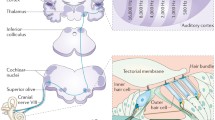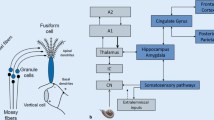Abstract
Animal models of tinnitus complement human findings and potentially deepen our insight into the neural substrates of tinnitus. The fact that animal data are largely based on recordings from the auditory system, in particular from subcortical structures, makes comparison with human electrophysiological data from predominantly cortical areas difficult. Electro/magnetoencephalography and imaging data extend beyond the auditory cortex. The most challenging link to be made is the one between the macroscopic data in humans and the microscopic (single neuron action potentials) and mesoscopic (local field potentials) results obtained in animal models. Since invasive recordings in humans are rare, a bridge needs to be built on the basis of changes in brain rhythms in animals with putative tinnitus.
Zusammenfassung
Tiermodelle von Tinnitus vertiefen unsere Erkenntnisse bezüglich der neuralen Substrate des Tinnitus. Dass die tierexperimentellen Daten weitgehend auf Untersuchungen des auditorischen Systems und hier insbesondere der subkortikalen Strukturen basieren, erschwert die Vergleichbarkeit mit menschlichen elektrophysiologischen Daten dominant kortikaler Bereiche. Die Ergebnisse der Elektro- oder Magnetenzephalographie und die Bilddarstellungen gehen über die des auditorischen Kortex hinaus. Am schwierigsten ist es jedoch, Verbindungen zwischen makroskopischen Daten aus Humanstudien sowie mikroskopischen (einzelne neuronale Aktionspotenziale) und mesoskopischen Ergebnissen (lokale Feldpotenziale) aus Untersuchungen an Tiermodellen zu ziehen. Da invasive Entnahmen beim Menschen selten vorgenommen werden dürfen, muss die Brücke auf Grundlage der beobachteten Veränderungen im Rhythmus der Hirnströme von Tieren mit mutmaßlichem Tinnitus geschlagen werden.
Similar content being viewed by others
References
Arnold W, Bartenstein P, Oestreicher EWR, Schweiger M (1996) Focal metabolic activation in the predominant left auditory cortex in patients suffering from tinnitus: a PET study with [18F]deoxyglucose. ORL J Otorhinolaryngol Relat Spec 58:195–199
Boyen K, Langers DRM, Kleine E de, Dijk P van (2013) Gray matter in the brain: differences associated with tinnitus and hearing loss. Hear Res 295:67–78
Eggermont JJ (1992) Neural interaction in cat primary auditory cortex. Dependence on recording depth, electrode separation and age. J Neurophysiol 68:1216–1228
Eggermont JJ (2013) Hearing loss, hyperacusis, and tinnitus: what is modeled in animal research? Hear Res 295:140–149
Geven LI, Kleine E de, Willemsen ATM, Dijk P van (2014) Asymmetry in primary auditory cortex activity in tinnitus patients and controls. Neuroscience 256:117–125
Husain FT, Medina RE, Davis CW et al (2011) Neuroanatomical changes due to hearing loss and chronic tinnitus: a combined VBM and DTI study. Brain Res 1369:74–88
Landgrebe M, Langguth B, Rosengarth K et al (2009) Structural brain changes in tinnitus: grey matter decrease in auditory and non-auditory brain areas. Neuroimage 46:213–218
Langers DM, Kleine E de, Dijk P van (2012) Tinnitus does not require macroscopic tonotopic map reorganization. Front Syst Neurosci 6:2
Langguth B, Eichhammer P, Kreutzer A et al (2006) The impact of auditory cortex activity on characterizing and treating patients with chronic tinnitus—first results from a PET study. Acta Otolaryngol Suppl 556:84–88
Melcher JR, Knudson IM, Levine RA (2013) Subcallosal brain structure: correlation with hearing threshold at supra-clinical frequencies (> 8 kHz), but not with tinnitus. Hear Res 295:79–86
Muhlau M, Rauschecker JP, Oestreicher E et al (2006) Structural brain changes in tinnitus. Cerebral Cortex 16:1283–1288
Noreña AJ, Eggermont JJ (2003) Changes in spontaneous neural activity immediately after an acoustic trauma: implications for neural correlates of tinnitus. Hear Res 183:137–153
Noreña AJ, Eggermont JJ (2005) Enriched acoustic environment after noise trauma reduces hearing loss and prevents cortical map reorganization. J Neurosci 25:699–705
Noreña AJ, Eggermont JJ (2006) Enriched acoustic environment after noise trauma abolishes neural signs of tinnitus. Neuroreport 17:559–563
Noreña AJ, Gourévitch B, Aizawa N, Eggermont JJ (2006) Spectrally enhanced acoustic environment disrupts frequency representation in cat auditory cortex. Nat Neurosci 9:932–939
Noreña AJ, Tomita M, Eggermont JJ (2003) Neural changes in cat auditory cortex after a transient pure-tone trauma. J Neurophysiol 90:2387–2401
Pienkowski M, Eggermont JJ (2009) Recovery from reorganization induced in adult cat primary auditory cortex by a band-limited spectrally enhanced acoustic environment. Hear Res 257:24–40
Roberts LE, Eggermont JJ, Caspary DM et al (2010) Ringing ears: the neuroscience of tinnitus. J Neurosci 30:14972–14979
Schecklmann M, Lehner A, Poeppl TB et al (2013) Auditory cortex is implicated in tinnitus distress: a voxel-based morphometric study. Brain Struct Funct 218:1061–1070
Schneider P, Andermann M, Wengenroth M et al (2009) Reduced volume of Heschl’s gyrus in tinnitus. Neuroimage 45:927–939
Seki S, Eggermont JJ (2002) Changes in cat primary auditory cortex after minor -to-moderate pure-tone induced hearing loss. Hear Res 173:172–186
Seki S, Eggermont JJ (2003) Changes in spontaneous firing rate and neural synchrony in cat primary auditory cortex after localized tone-induced hearing loss. Hear Res 180:28–38
Acknowledgments
This research was supported by Alberta Innovates-Health Solutions, the Natural Sciences and Engineering Research Council of Canada, and the Campbell McLaurin Chair for Hearing Deficiencies.
Compliance with ethical guidelines
Conflict of interest. J.J. Eggermont states that there are no conflicts of interest.
All studies on humans described in the present manuscript were carried out with the approval of the responsible ethics committee and in accordance with national law and the Helsinki Declaration of 1975 (in its current, revised form). Informed consent was obtained from all patients included in studies.
All national guidelines on the care and use of laboratory animals have been followed and the necessary approval was obtained from the relevant authorities.
Author information
Authors and Affiliations
Corresponding author
Rights and permissions
About this article
Cite this article
Eggermont, J. Neural substrates of tinnitus in animal and human cortex. HNO 63, 298–301 (2015). https://doi.org/10.1007/s00106-014-2980-8
Published:
Issue Date:
DOI: https://doi.org/10.1007/s00106-014-2980-8




